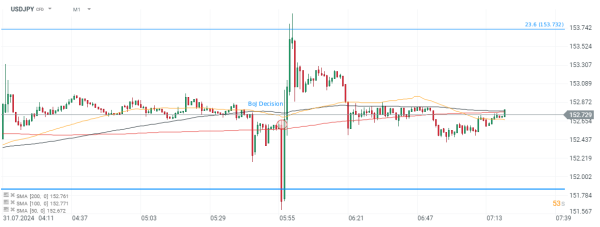Morning wrap (31.07.2024)
- Microsoft's quarterly report for Q2 2024, although higher than forecasts, failed to improve sentiment around the company. Margins in several of the company's key segments turned out to be the lowest in all of 2024. Revenues grew 15% y/y vs. 30% y/y growth in Azure sales (the company expected 30-31% y/y).
- The slightly better-than-expected results were not enough to improve sentiment, with market expectations high; Micorosft is now losing about 3%, although it was losing more than 7% in the first reaction. AMD shares, on the other hand, are gaining more than 7% following Q2 results.
- Data center sales rose 115%; the company managed to beat forecasts for revenue (up 9% y/y) and earnings ($0.69 per share vs. $0.68 forecasts). The company raised forecasts for Q3 2024. On the wave of this publication, US100 contracts are trading up today, supported by a recovery in sentiment in the semiconductor sector
- The Bank of Japan raised rates by 15 basis points to 0.25% against forecasts of keeping them unchanged, at 0.1%. The Japanese yen experienced tremendous volatility during the Bank of Japan's decision - initially weakening to around 151, before rebounding to 154. The pair is currently stabilizing at 152.8 and trading virtually unchanged from before the decision
- At the same time, the BoJ announced a reduction in bond purchases to about 3 trillion yen ($19.6 billion) per month in the first quarter of 2026. Analysts had expected a more aggressive cut. Investors await BoJ Governor Ueda's speech
- Japanese indices gained slightly; the Nikkei traded flat and the Topix rose 0.45%. Building permits in Japan fell -6.7% y/y vs. -2.4% forecasts and -5.3% previously. Consumer sentiment in Japan indicated 36.7, marginally above 36.6 forecasts and 36.4
- Japan's retail sales, however, rose 3.7% y/y vs. 3.3% expectations and 2.8% previously. Industrial production fell -7.7% y/y vs. 1.1% growth previously. In m/m terms, however, the decline was slightly smaller than expected at -3.6% vs. -4.8% forecast and -3.6% previously
- China's Hang Seng rose more than 2.1%, despite mixed data out of China. Along with the Chinese indices, the ASX and Korea's KOSPI rose by 1.5% and 0.5%, respectively. India's SENSEX soared to new historic highs and gained 0.3%
- China's service sector PMI came in at 50.2 versus 50.2 expectations and 50.5 previously. The combined index was 50.2 versus 50.5 in May. The NBS manufacturing sector PMI came in at 49.5, marginally higher than the 49.3 expected, but marginally weaker than the 49.5 previously
- Data from Australia showed a decline in the RBA's median measure of inflation to 0.8% quarter-on-quarter vs. 1% forecast and 1.1% previously (year-on-year indicated 4.1% vs. 4.4% previously) . CPI y/y and k/k data came in line with expectations at 3.8% and 1%, respectively.
- Retail sales in Australia rose m/m by 0.5% versus 0.2% forecast and 0.6% previously. Also, activity indicators from New Zealand came in higher than before
- Oil futures gain after API report; WTI records nearly 1.2% jump. Inventories fell by nearly -4.5 million barrels vs. -3.9 million drop previously. Gasoline stocks are down -1.91 million barrels, versus -2.8 million previously, and distillate stocks are down -322,000 barrels, versus -1.5 million previously
- The Eurodollar is trading up nearly 0.1%, with marginally better sentiment observed among precious metals. Wheat contracts on the CBOT deepen declines to $520 a bushel, retreating nearly 0.8%.
- U.S. election polls indicate that support for Harris is gradually rising, giving Democrats hope for a 'fight' in the US November elections.
USDJPY (M1 interval)
 Source: xStation5
Source: xStation5